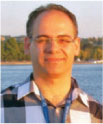Articles citing this paper
How well can we predict and measure metal speciation in freshwaters?
John Hamilton-Taylor A B , Imad A. M. Ahmed A , William Davison A and Hao Zhang AA Lancaster Environment Centre (LEC), Lancaster University, Bailrigg, Lancaster LA1 4YQ, UK.
B Corresponding author. Email: j.hamilton-taylor@lancaster.ac.uk

John Hamilton-Taylor, a graduate of Swansea University (B.Sc.) and Edinburgh University (Ph.D. (Aquatic geochemistry)), has been a Reader in Aquatic Geochemistry at Lancaster University since 1995. His main interests relate to the biogeochemistry of metals and dissolved organic matter in aquatic, soil and sediment systems, and include studies of biogeochemical processes, element cycling and chemical speciation. |

Imad Ahmed is a graduate from Al Aqsa University, Palestine (B.Sc. (Physics and Chemistry)) and the University of Nottingham (M.Sc. and Ph.D. (Environmental Science)). In 2007, he moved to the School of Earth and Environment, Leeds University, to work as a postdoctoral research fellow. In 2009, he joined the Aquatic Chemistry team at the Lancaster Environment Centre as a Senior Research Associate. His research interests include the biogeochemical cycling of trace elements in natural waters and terrestrial environments. He is particularly interested in the development of new analytical methods and the application of synchrotron radiation-based spectroscopy and scattering methods to problems in geochemistry, environmental chemistry and solid state chemistry. |

Bill Davison has been Professor of Environmental Chemistry at the University of Lancaster for 20 years where his research has focussed on using diffusion gradients in thin-films to understand the dynamics of chemical speciation in solution and of solute–solid phase interactions in sediments and soils. Previously he was Head of Chemistry at the Institute for Freshwater Ecology where his research on biogeochemistry included redox-related processes in lakes. He is a graduate of the University of Newcastle upon Tyne (B.Sc. (Chemistry) and Ph.D. (Electrochemistry)) and has published more than 200 peer-reviewed papers. |

Hao Zhang is Reader in Environmental Chemistry and has 27 years of research experience in chemical speciation and biogeochemistry of trace metals in aquatic systems. After gaining her B.Sc. in Chemistry at the China Ocean University, Qingdao in 1984 she worked at the Oceanography Institute, the Chinese Academy of Sciences (1984–87), the University of Brussels (1987–91, Ph.D.), Liverpool University (1992) and Lancaster University (1993–present) where she has developed the diffusion gradients in thin-films technique and advanced understanding of biogeochemical processes affecting trace metals and other inorganic components in waters, sediments and soils. She has published more than 100 peer-reviewed papers. |
Environmental Chemistry 8(5) 461-465 https://doi.org/10.1071/EN11031
Submitted: 12 March 2011 Accepted: 27 May 2011 Published: 4 October 2011


